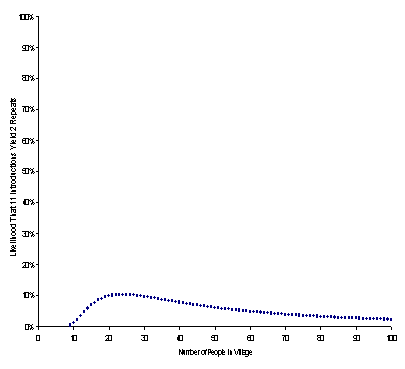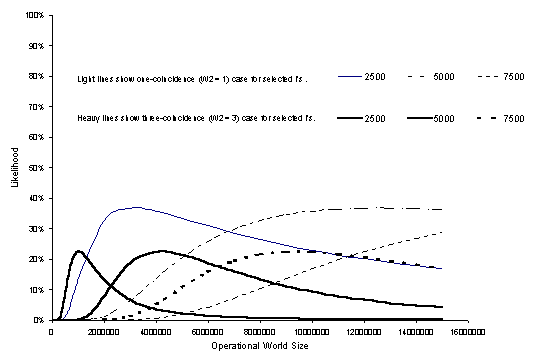Another
View of Small World
Brian
McCue, Center for Naval Analyses
This
afternoon I am going to take a look at "The Small World Networks"
in a little different way than other literature has done. The giant sized
footprints of Duncan Watts and Peter Dodds notwithstanding, I have found
a different way of looking at small worlds, that is quite consistent with
the aphorisms we use.

Click
image for enlargement
When
someone pops up that you've been introduced to before, you say, "It's
a small world".
 When
we meet someone in an unexpected contex, there is an element of coincidence
there. For example, if we meet a lieutenant at the SSG among all these
colonels and captains. And then he pops up at a MORS meeting, you aren't
that surprised, because he must be a smart guy. Anyhow, that's how I met
Jeff Cares. I didn't say "It's a small world." When
we meet someone in an unexpected contex, there is an element of coincidence
there. For example, if we meet a lieutenant at the SSG among all these
colonels and captains. And then he pops up at a MORS meeting, you aren't
that surprised, because he must be a smart guy. Anyhow, that's how I met
Jeff Cares. I didn't say "It's a small world."
I
did say this when I had a job interview and a few hours later, I witnessed
a car accident. I pulled over to be a witness to the incident and out
pops the person I just had an interview with... now THAT's when you say,
"It's a small world!"
(I
did get the job, by the way.)
The
small world literature largely addresses:
- Lengths
of typical acquaintance chains (ex.
the Kevin Bacon game, “six degrees of separation” joining
individuals, etc.).
- Sizes
of typical acquaintance volumes (numbers of people known to an individual.)
- Network
structures of individuals’ acquaintanceships.
It
is hard for people to determine how many people they know. How do you
define "know"? Is it that you know their name, or know them
well enough to call them by their first name, or that you can touch them?
It is hard to estimate how many people people know. People may know someone
enough to recognize them when they walk through the door.
When
we say, "It's a small world," are we talking about acquaintance
chain, acquaintance volume or are we saying something about structures?
Now
if we meet someone at a meeting, for example a woman whom we met at church.
Would we say, "It's a small acquaintance chain"? No. Duh!
Would
we, in the same circumstance blurt out, "It's a small acquaintance
volume?" Definitely not a good pick up line. Because that would mean
we don't know very many people. That's not what we are expressing when
we meet someone in an unexpected context.
What
we are saying is that it is a small world, because I keep sampling it,
at not a great rate, but I keep getting these "repeats".
 When
we meet someone we are "pulling a ball out of an urn". And we
keep getting the same ones. That must mean that there are not that many
balls in the urn. It must be a small world because I sample the world,
at not great rate, and keep getting repeats. The "small world"--or
the operational world--is the world from which we would be sampling, if
we were sampling randomly from a structuraless world. And the fact that
the virtual, operational world is "small" is a statement about
the "real world". When
we meet someone we are "pulling a ball out of an urn". And we
keep getting the same ones. That must mean that there are not that many
balls in the urn. It must be a small world because I sample the world,
at not great rate, and keep getting repeats. The "small world"--or
the operational world--is the world from which we would be sampling, if
we were sampling randomly from a structuraless world. And the fact that
the virtual, operational world is "small" is a statement about
the "real world".
The
factors are:
-
Length
of the Chain: How many steps are you from the other person?
-
Volume:
How many people do you know?
In
regards to Kevin Bacon, he has a large acquaintance volume, because of
the numbers of films and diversity of films he has made. He is probably
connected by short chains, to you, because of the volume, but that assumes
something about sampling.
The small world that I am talking about has a very large estimate of people,
but not an infinite number, from which I'm sampling, and getting these
repeats. If I sampled without structure,
if I were truly sampling the world at random, how big would it be to get
me the level of repeats that I'm getting?
In
fact, I sample in a very structured way:
- I live in North America
- I work with academic type people (most of whom don't see movies)
Of
the six billion people in the world, there are just people whom I'm not
going to meet! But there is a size that the world could be, if I were
sampling it randomly, and get the number of repeats that I'm getting.
I
suppose I should mention the town of Maybury.
So,
the evocation of this imaginary, structuraless world, is a statement about
the real, large, structured world.
If
you actually got the size of the world, and it turned out to be... 600.
That doesn't say that you know 600 people, but you are sampling in such
a way that you may not even meet all the people in that world, for example
you live in a monastery and only interact with a few individuals.
When
we say that it's "plane sailing" it means that you can pretend
the world is flat. Now does the navigator think that the world is really
flat? No. Does he say the world is flatter that the last time he traveled
across it? No.
He
is saying this, because he is close enough to his destination to act as
if it were so. His fictitious statement that the world is flat, however,
is a statement that reflects the real situation.
The
sample that we are pulling from is a condition of probability (ex. a person
working in their profession will meet more random people and repeats within
their profession. The personal condition determines the "urn"
from which we can draw samples.
Estimating
the Operational World
The
evocation of this imaginary, small, structureless world is a statement
about the structure of the real, large, structured world.
We
will estimate the size of this "operational world" and thereby learn about
the real world.
The
math starts here (for accurate representations of formulas, download
presentation:
- W = size
of an individual's "world" (Does not include individual herself.)
- I = Number
of meetings she has had
- Ik=
number of meetings of person k (Ik is defined
for k = 1, 2, W)
- Wj
= number of individuals met j times (Wj is defined
for j = 0, 1, 2,...I )
 Dropping
I balls over W boxes Dropping
I balls over W boxes
- W I ways
do to it.
- We don't
care about the order of introductions.
- We don't
care which person is which.
A
box with two balls is a coincidental re-introduction.We are dropping balls
(which are introductions) to boxes (that are people).
Small
Village Sample
A
vistitor meets randomly 9 people, two of them twice, given the total popluation
of W, the probabilty of this happening is 24 people are probably in the
village.
Now
we are going to try to get real. W1 the number of people that we have
met one time and I1.
We
can not ask you how many people there are in the world.

Likelihood,
A Function of W
Probability,
given W, that what happened would happen. Can be used to estimate W. Suggests
that there are about 24 people.

Realistic
Numbers
W1
and I1 are nearly equal to I These equal a few thousand for most people,
but can only be estimated approximately. For j,k > 1,Wj and Ik are small
and people might recall them.
More
Definitions
The
number of surprise introductions are remembered because they do not occur
that often.

How
do you estimate I?

S = Ic - Wc
S
is the number of surprising reintroductions.
Likelihood
of W, re-written


With
the first part of the answer being things a person might remember. What
the person doesn't remember has factorial = 1 so it doesn't matter.
Maximizing
L(W)
L(W)
still contains factorials of some big numbers. But we can find the W that
maximizes by finding W such that...

Estimating
I
The
phonebook test of Freeman and Thompson presents 301 surnames and asks
the subject how many are names of people she knows.
I
= score x total names in book/301. Book contains about 100,000 names.
Typical result is 1,000 - 6,000.
Estimating
W
A
person has I = 2000, S = 1: this leads to a W of about 2,000,000 in:
If
I = 4,320 and S = 12, W = 775,000
But
it's worth computing L(W)

Observations
on likelihoods
Maxima
are surprisingly high. Even S = 3 is enough to make a distinct peak. Resulting
world sizes are:
- Much less than the real world's size.
- Comparable to (mostly less than or equal to) city sizes.
Conclusions
We
each might as well be drawing a lifetime's introductions from a small
city.
For
people who really do draw introductions from limited populations, coincidental
re-introductions could be used to estimate I.
Discussion
But
what about those acquaintance chains, and the six degrees of separation?
In light of US population size and estimates of I, six degrees is surprisingly
many, not surprisingly few. For a random structure, four degrees would
be plenty. Small world-size suggests that extra degrees are needed to
make jumps from world to world.
What
about the six degrees of freedom? What about the introductions? If you
know at least 1000 poeople, you should be able to get to everyone in the
US. You need the extra steps to be able to get from one cluster to the
next.
Future
work
- Get solid work on conicidental re-introductions
- Do
math to find: why
- Think
about how small worlds might connect and how we could, perhaps, through
coincidental reintroductions, discover how they really do connect.
Questions
Military
Applications: This paper grew out of U-boat war. How many enemy transfer
records have we not heard. How many have we not detected.
Milgram
decided that we were connected by chains that were very short. Tracked
things and got an average of six with a package that might get to a particular
person who knows.
Partial
Bibliography
Manfred
Kochen (editor), 1989, The Small World, Ablex Publishing Corporation,
Norwood, MA. Includes the following chapters: H. Russell Bernard, Eugene
C. Johnsen, Peter D. Killworth, Scott Robinson, “Estimating the Size
of an Average Personal Network and of an Event Subpopulation.”
Linton
C. Freeman and Claire R. Thompson, “Estimating Acquaintanceship Volume.”
Alden S. Klovdahl, “Urban Social Networks, Some Methodological Problems
and Possibilities”
Ithiel
de Sola Pool and Manfred Kochen, “Contacts and Influence,” originally
published in Social Networks 1 (1978), pages 5-51.
Brian
McCue, “Estimating the Number of Unheard U-boats: A Problem in Traffic
Analysis,” 2000, Military Operations Research, Volume 5, Number 4,
pp 5-18.
Stanley Milgram, “The Small World Problem,” 1967 Psychology
Today 1, pp 61-67.
Ray
Solomonoff and Anatol Rapaport, 1951, “Connectivity of Random Nets,”
Bulletin of Mathematical Biophysics 13, pp 107-117.
Ray
Solomonoff, 1952, “An Exact Method for the Computation of the Connectivity
of Random Nets,” Bulletin of Mathematical Biophysics 14, pp 153-157.
Jeffrey
Travers and Stanley Milgram, 1970, “An experimental study of the
small world problem, “ Sociometry 32, pp. 425-443.
Duncan
Watts, 1999, Small Worlds: The Dynamics of Networks between Order and
Randomness, Princeton, Princeton University Press.
|

